British Rail Class 43 (HST)
The British Rail Class 43 (HST) is the TOPS classification used for the InterCity 125 High Speed Train (formerly classes 253 and 254) power cars, built by British Rail Engineering Limited from 1975 to 1982, and in service in the UK since 1976.
| British Rail Class 43 (HST) | |||||||||||||||||||||||||||||||||||||
|---|---|---|---|---|---|---|---|---|---|---|---|---|---|---|---|---|---|---|---|---|---|---|---|---|---|---|---|---|---|---|---|---|---|---|---|---|---|
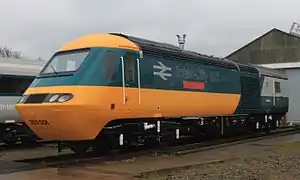 Powercar 43002 'Sir Kenneth Grange' restored to the original Intercity 125 livery in May 2016 | |||||||||||||||||||||||||||||||||||||
| |||||||||||||||||||||||||||||||||||||
| |||||||||||||||||||||||||||||||||||||
| |||||||||||||||||||||||||||||||||||||
| |||||||||||||||||||||||||||||||||||||
The class is officially the fastest diesel locomotive in the world, with an absolute maximum speed of 148 mph (238 km/h), and a regular service speed of 125 mph (201 km/h). The record run was led by 43102 (43302) and trailed by 43159.[1][2]
History and background
In the early 1970s, the British Railways Board made the decision to replace its main-line express diesel traction. Financial limitations were tight, so mass electrification was not possible. As a result, a new generation of high-speed diesel trains had to be developed.
Experience with the high-speed Class 55 Deltic locomotives had shown that a low axle weight was essential to avoid damage to the track at sustained high speed, and that high-speed engines were the only way to provide a good enough power-to-weight ratio for diesels. To power the HST at up to 125 mph (201 km/h), each power car had a new diesel engine, the 12-cylinder Paxman Valenta, running at 1,500 rpm and developing 2,250 bhp (1,680 kW). The 70-tonne weight of the power car gave it a 17.5-tonne (per-)axle loading.
Development and design
Prototype
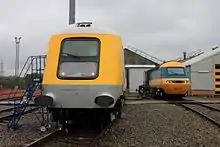
The prototype set was developed at the Railway Technical Centre, Derby, the power cars having been constructed by British Rail Engineering Limited's (BREL) Crewe Works and the British Rail Mark 3 passenger cars by BREL's Derby Litchurch Lane Works. The engine used in the prototype power cars was the Paxman 'Valenta' 12RP200L, which developed 2,250 horsepower (1,680 kW). The electrical equipment was supplied by Brush. The power cars had a main driver's position at one aerodynamically shaped end with the other flat and gangwayed end having only an auxiliary driving position for shunting purposes.
The two prototype power cars emerged from the works in June and August 1972 and were initially numbered 41001 and 41002, but after a short period the entire set, including the passenger coaches, became reclassified as a diesel-electric multiple unit: British Rail Class 252. The power cars were given the coaching stock numbers 43000 and 43001. After proving trials on the Eastern Region the prototype High Speed Diesel Train (HSDT) was transferred to the Western Region, where it was deployed on Paddington Bristol/Weston-super-Mare services.
In May 2011 the National Railway Museum (NRM) announced that the remaining HST prototype power car 41001 would undergo full restoration work.[3] A long-term loan was agreed between the NRM and the 125 Group of volunteers for the locomotive and a Paxman Valenta RP200L engine. The replacement engine (no. S508) was required as the original Valenta engine (no. S183) had been sectioned for display purposes. The S508 engine was lifted into the locomotive at Neville Hill TMD on 29 June 2012.[4] The loan agreement ended in November 2019 and 41001 returned to the NRM.[5]
In order to facilitate a main line move, Class 41 prototype HST power car 41001 was re-registered as a Class 43/9 locomotive, with the number 43000. It is the only locomotive in this sub-class.[6]
Production series
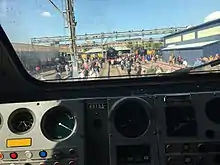
The design was successful and led to production orders being placed for similar trains for the Western, Eastern, Scottish and London Midland Regions. The production power cars featured a redesigned front end without conventional buffers, although a rigid drawbar can be used to connect an HST to an ordinary locomotive. Following the introduction of production HST sets, the prototype unit was withdrawn, the power cars passing to the Research Division at Derby. Of the ten prototype coaches, two were adapted for use in the Royal Train,[7] five were modified for use with the production HSTs,[8] and three were transferred to Departmental stock.[9]
The 197 power cars produced are numbered 43002-43198. 43001 was applied to the second of the two prototype power cars, while the first of the pair (now preserved and operational at the Great Central Railway (Nottingham) became 43000, which is unusual because BR TOPS classification numbered its locomotives from 001 upwards (this was because it was not, at the time, classified as a locomotive).
Buffered units
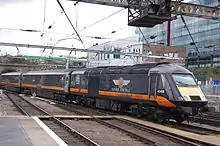
In 1987, as electrification of the East Coast Main Line was under way, British Rail realised that the new Mark 4 carriages for the Class 89 and Class 91 locomotives were not going to be finished in time for the introduction of electric services on the East Coast Main Line so, in late 1987, a total of eight Eastern Region power cars (Numbers 43013/014/065/067/068/080/084/123) conversions (on 43014/123) were carried out at the Derby Engineering Development Unit, whilst the other six (43013/065/067/068/080/084) were converted by the diesel repair shop at Stratford to have the lower valancing removed and buffers fitted.
After being fitted with buffers, these power cars began work as surrogate DVTs to work with the Class 91s and 89. The locomotives, working with conventional Mk3 stock, worked on the line between 1987 and 1991, when the last Class 91 locomotives entered service. As well as buffers being fitted to these powercars, special remote control equipment was also added to the locomotives so they could be controlled by the locomotive at the front. Once these locomotives left DVT duties, the remote equipment was removed.
After privatisation, these power cars joined the Virgin Trains fleet working both Virgin CrossCountry and Virgin Trains West Coast routes, where they displaced loco-hauled stock. All the units were repainted from their original InterCity colours to the Virgin red livery. Later, Virgin Trains withdrew the HSTs when new Class 220 and 221 units were delivered, and nearly all of these power cars went into storage at Long Marston.
After years of storage, several of the powercars were bought by Midland Mainline to be part of Project Rio, special services running from London St Pancras to Manchester while major engineering works were undertaken on the West Coast Main Line. These units were kept in the de-branded Virgin Trains livery throughout their time with Midland Mainline and put back in storage once Project Rio had finished in 2006.
43013 and 43014 joined Network Rail's New Measurement Train in 2003 and have continued to work with this service ever since. Both of these units have now had MTU engines fitted.
43080 was leased to GNER as a one-off powercar, working as a spare unit that could be easily called for if a HST failed. For most of its time with GNER, it was based at Craigentinny yard in Edinburgh and was painted into GNER colours. This locomotive's lease ended in 2006 and it was returned to storage at Long Marston.
In 2007, Grand Central took an interest in the stored power cars and amalgamated them into its fleet of three HST sets. In total, 43065/067/068/080/084/123 were bought by the company and now run high-speed services between Sunderland and London Kings Cross. HSTs 43084 and 43123 were the final operational Paxman Valenta power cars, being re-engined in 2010 with the MTU treatment. While at the works being re-engined, Grand Central added the orange stripe that appears on its Class 180 units, re-painted the front ends (making them look more like the non-buffered HSTs), and re-numbered the power cars into the four-hundreds. These are the current numbers: 43465 (065)/467 (067)/468 (068)/480 (080)/484 (084)/423 (123).
Engines
.JPG.webp)
British Rail experimented with Mirrlees Blackstone MB190 engines in four Western region examples (43167–43170) between 1987 and 1996, but this experiment was unsuccessful and the standard Paxman Valenta engines re-installed. These four locomotives have since all been re-engined with the MTU 16V4000 engines. 43167 is now 43367 and operates with London North Eastern Railway, whilst 43168-43170 are still in service, in the former Western region area under Great Western Railway
Paxman began development of the Valenta's successor, the VP185, in 1987. The suggestion that British Rail participate in a trial of the new VP185 engine in the IC125 was first mooted in January 1991, and a formal agreement for the trial was signed in May 1993.[10]
A qualifying requirement for the trial was that the engine should undergo a British Rail Type Test which was carried out between December 1993 and February 1994.[10] The test involved completion of 3,000 cycles, each of 10 minutes duration, with four minutes at the maximum power of 2,611 kW (3,501 bhp) and six minutes at idle, simulating the typical 'on-off' nature of IC125 duty. The test was much more severe than operational duty, where the train operates at a maximum of 1,678 kW (2,250 bhp). The successful results of the test cleared the way for installation of a VP185 in Power Car 43170 at Plymouth Laira Depot for in-service trials in the summer of 1994. Power car 43170 entered service on 22 September 1994.[10] 43170 was given the nameplate "Edward Paxman".[11]
During the late 1990s twenty-five HST power cars were re-engined with Paxman 12VP185L engines in order to improve fuel consumption and reduce emissions.
The last VP185 engine to be manufactured at Paxman's Colchester Works was despatched from the factory on 15 September 2003 as part of a program to convert 14 Midland Mainline power cars to VP185 engines to supplement the four already converted during 1994/95, and this led to 43043/045/048-050/052/055/060/061/072/073/076/082 joining 43047/059/074/075 with this engine type.[12]
Today there are no production power cars fitted with a Paxman Valenta engine, although the 125 Group have reinstalled a Paxman Valenta in the surviving prototype powercar, 41001 (formerly 43000).
Diesel-battery hybrid trial
In 2007 Brush Traction and Hitachi equipped Paxman Valenta powered 43089 and a semi-permanently coupled Mark 3 coach with a diesel-battery hybrid power system for experimental trials. The power car was named "Hayabusa" (Hayabusa, はやぶさ, Japanese for Peregrine falcon, project name 'V-Train 2').[13][14][15] It returned to normal service with East Midlands Trains.
Life extension
The HST, having been in operation since the late 1970s, is due for replacement by the Hitachi Super Express. The development cycle for the replacement series is such that the existing fleet may be required to operate through to 2019 or beyond.
- During 2005, two Class 43 power cars (43004 and 43009) operated by First Great Western were fitted with new MTU V16 4000 engines before being tested in passenger operation on the Great Western Line. In December 2005, First announced that all its power cars would receive the MTU engine. The MTU engine offers improvements over the existing Paxman 12RP200 'Valenta' engines, with reduced noise, smoke and exhaust emissions, improved reliability and fuel efficiency.[16]
- East Coast also re-engined its fleet with MTU engines, a process begun under its predecessor GNER. East Coast's fleet of re-engined power cars have been renumbered into the 432xx and 433xx series by adding 200 to the existing power car number.
- East Midlands Trains stated that it would install Paxman VP185 engines in all its powercars before the end of its franchise. It has since completed this operation, though the re-engined power cars retain their original numbers
- Grand Central had fitted their HST fleet with MTU engines, with the first pair entering service on 21 September 2010; they have also been repainted with an orange stripe to match Grand Central's Class 180s.[17] 43123 was the final Valenta powercar; it now carries a plaque reading "Valenta 1972-2010". The final passenger service of a Valenta engined power car was on 19 December 2010. On 22 December 2010 the Valenta was used in four farewell tours between York and Sunderland using 43123. All power cars have been re-engined by Brush Traction, Loughborough, and have been renumbered in the 43/4 range.
- CrossCountry's first CrossCountry-liveried HST powercar, 43301 (formerly 43101) was released from its overhaul at Brush Traction, Loughborough on 16 July 2008. To identify its fleet, CrossCountry is renumbering all its HST units by adding an extra 200 to the old number.
- Network Rail's New Measurement Train is a specially converted InterCity 125. It can check the condition of railway lines over a 13-week cycle. On the West Coast Main Line, care is taken so tilting trains can safely run. It measures contact between wheels, rails and overhead power lines and is equipped with lasers, video cameras and other instruments. It was launched in 2003, but the vehicles used for it are older. Its yellow livery has earned it the nickname "The Flying Banana", which was previously used for older High Speed Trains with a similar livery.
Operations
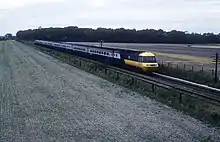
.jpg.webp)
When Crewe Works built them, the InterCity 125 units were considered to be diesel multiple units, and were allocated Classes 253 and 254 for Western and Eastern Region services respectively. The locomotives were introduced in the Midland region later.
Until the HST's introduction, the maximum speed of British trains was limited to 100 mph (160 km/h). The increased speed and rapid acceleration and deceleration of the HST made it ideal for passenger use, and it slashed journey times around the country. The prototype InterCity 125 (power cars 43000 and 43001) set the world record for diesel traction at 143 mph (230 km/h) on 12 June 1973. An HST also holds the world speed record for a diesel train carrying passengers. On 27 September 1985, a special press run for the launch of a new Tees-Tyne Pullman service from Newcastle to London King's Cross, formed of a shortened 2+5 set, briefly touched 144 mph (232 km/h) north of York.
During 1987, eight HST power cars were converted for use as driving van trailers (DVTs) with Class 91 locomotives during trials on the East Coast Main Line. The power cars were fitted with buffers and Time Division Multiplex equipment that allowed them to directly control a Class 91, and were moved over to the ECML where they were used on workings with Class 89 and then Class 91 locomotives from London to Leeds. After the Mk 4 stock had been delivered, the HST power cars had the TDM equipment removed, and then reverted to their normal duties. The power cars used for this project can be easily identified as they are still fitted with buffers. They were then transferred to Virgin Cross Country, and put in storage when Virgin replaced its HST fleet with Bombardier Voyagers (though Arriva, upon later taking over the franchise, acquired 10 power cars, 4 of which were buffered). Grand Central bought six of these for services from Sunderland to London, the remaining two having been integrated into Network Rail's New Measurement Train. This train is being replaced by IET Class 801 and Class 802. Bi mode trains.
After the privatisation of British Rail the HST sets continued to be used. 194 of the 197 locomotives built remain in service. The three units that are not in service, 43173, 43011 and 43019, were written off by fatal rail accidents in 1997, 1999 and 2004 respectively.
All HSTs operating with Great Western Railway, London North Eastern Railway were replaced by Class 800/801/802s in 2018/2019. Twenty-seven sets each with four or five carriages moved from Great Western Railway to Abellio ScotRail and be refurbished with controlled emission tanks and plug automatic doors. They will operate on services from Edinburgh and Glasgow to Aberdeen and Inverness.[18][19][20][21] The first two were delivered to Craigentinny TMD for crew training in September 2017.[22] The first entered service in October 2018.[23]
Great Western Railway retained 24 powercars to form 11 four-carriage formations known as "Castle Class" sets for use on local services between Cardiff and Penzance.[24]
Future
GB Railfreight have expressed interest in the possibility of converting displaced HST sets for use carrying parcels and other mail.[25]
Fleet
Summary
| Status/Operator | Image | Number | Unit nos. | Notes |
|---|---|---|---|---|
| Abellio ScotRail |  |
53 | 43003, 43012, 43015, 43021, 43026, 43028, 43031-43037, 43124-43139, 43141-43152, 43163-43164, 43168-43169, 43175-43177, 43179, 43181-43183, 43185 |
|
| Colas Rail | 2 | 43050, 43060 | Former East Midlands Railway cars to be repainted and used for test train purposes. | |
| CrossCountry |  |
13[26] | 43207, 43208, 43239, 43285, 43301, 43303-43304, 43313, 43321, 43357, 43366, 43378, 43384 |
|
| East Midlands Railway | .JPG.webp) |
18 | 43238, 43251, 43257, 43272, 43274, 43277, 43290, 43295, 43302, 43305-43307, 43309-43310, 43316-43317, 43319-43320 | 19 Class 43/0 powercars, all with MTU engines. Former London North Eastern Railway powercars. |
| Great Western Railway |  |
34 | 43004-43005, 43009-43010, 43016, 43022, 43040-43042, 43088, 43092-43094, 43097-43098, 43122, 43153-43156, 43158, 43160, 43162, 43170-43172, 43186-43189, 43192, 43194, 43196, 43198 |
|
| Locomotive Services Limited | 5 | 43046, 43055, 43058-59, 43083 | Former East Midlands Railway powercars. | |
| Network Rail |  |
3 | 43013, 43014, 43062 |
|
| Off-lease / Stored | 62 | 43030, 43140 | Stonehaven derailment stored at Glasgow Works. | |
| 43017, 43020, 43023-43025, 43027, 43029, 43053, 43056, 43063, 43069-43071, 43078-43079, 43086-43087, 43091, 43159, 43161, 43165, 43174, 43180, 43190-43191, 43193, 43195, 43197 | 28 former Great Western Railway powercars which have been stored at Long Marston, Laira and Ely. | |||
| 43206, 43300, 43311, 43312, 43315, 43367 | 6 Class 43/0 former London North Eastern Railway powercars were replaced by Class 800/Class 801s in December 2019. | |||
| 43043-045, 43047, 43049, 43052, 43054, 43061, 43064, 43066, 43073, 43075-43076, 43081-082 | The former 24 East Midlands Railway VP185 engine power cars were replaced by MTU engine power cars from London North Eastern Railway in December 2020. | |||
| 43296, 43299, 43308, 43314, 43318 | Former East Midlands Railway became off-lease. | |||
| 43423, 43465, 43467-43468, 43480, 43484 | Former East Midlands Railway replaced by Class 180 "Adelante" in December 2020. | |||
| Preserved |  |
4 | 43002, 43018, 43048, 43089 |
|
| Scrapped | 3 | 43011, 43019, 43173 |
|
List
| Key: | In service | Stored | Scrapped | Preserved |
|---|
Fortieth anniversary
_43185.JPG.webp)
On 2 May 2016 an open day was held at Bristol St Philip's Marsh depot with a line up of Class 43s from each operator (except Cross Country) to celebrate the HST's fortieth anniversary. Several locomotives and passenger trains also appeared, such as 150 247 and 166 214 both in their new GWR liveries, 158 798 in its Springboard Opportunity Group livery and the prototype Class 41 HST. At the event, powercar 43002 (Numbered 253 001 as a Diesel Multiple Unit) was unveiled in original Intercity 125 livery, and named Sir Kenneth Grange after the Class 43's bodyshell designer.[38] On 2 October 2016, powercar 43185 had been unveiled in InterCity Swallow livery.[39] Both were operated by Great Western Railway (First Great Western) and 43002 is now preserved.
Accidents
There have also been four serious incidents involving Class 43s; these accidents resulted in three power cars being written off. A fourth sustained severe damage in 2020, but has not yet been officially written off.
- Southall rail crash: on 19 September 1997, 43173 leading a Swansea to London Paddington service which failed to stop at a red signal, which resulted in a high-speed collision with a freight train.
- Ladbroke Grove rail crash: on 5 October 1999, a British Rail Class 165 unit 165 115, passed a signal set at danger while leaving London Paddington on a Thames Trains service. This resulted in a serious collision with 43011, forming a London-bound HST service.
- Ufton Nervet rail crash: on 6 November 2004, 43019 leading a London to Plymouth service, collided with a car on the Ufton Nervet level crossing. The impact with the car resulted in a serious derailment which killed six people aboard the train, including the driver.
- Stonehaven derailment: on 12 August 2020, 43140 leading an Abellio ScotRail service struck a landslide near Stonehaven on the Dundee-Aberdeen line, derailing the train and killing three.[40][41]
There have been minor incidents involving Class 43s, among which have been:
- On 28 August 1979, power car 43110 derailed south of Northallerton. The cause was attributed to low gearbox oil lubricant which caused the pinion to fail and lock the leading wheels on the train in place. With the rear power car pushing the train, this caused the locked wheels to skid, wearing a groove which developed false flanges on their outsides, one of which struck the points south of the station, which buckled the rail.[42]
- On 16 March 1986, power car 43118 received collision damage after running through a buffer stop and derailing, while leaving Neville Hill TMD.[43]
- On 20 August 2017, 43188 partly derailed on departure at Paddington while forming the rear power car of the 11:57 Great Western Railway service to Penzance. This was due to a track fault.[44]
- On 31 December 2017, 43195 hit a tree near Hemerdon, Plymouth.[45][46]
- On 17 April 2018, 43138 suffered damage due to an engine fire whilst at Penzance station.[47]
- On 6 April 2019, 43045 caught fire at Leicester whilst working 1B53 1445 Nottingham-London St Pancras.[48][49][50]
- On 13 June 2019, 43054 collided with aggregate that had been washed-out from a cutting slope near Corby, Northamptonshire.[51][52]
- On 13 November 2019, 43300 collided with an LNER Class 800 Azuma at Neville Hill TMD, Leeds.[53]
Powercar 43160 had two minor incidents, which happened at the South West England region.
- On 3 April 2016, the powercar was involved in what was described as a 'low impact' collision at Plymouth railway station. A local commuter service collided with a Plymouth to London Paddington train at low speed and the powercar received damage to its nose and valancing.[54]
- On 14 September 2017, around 1 year and 5 months after the 'low impact' collision incident, the powercar was severely damaged by a fire in Exeter.[55]
Replacement
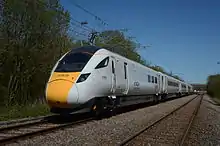
Built between 1975 and 1982, the fleet is now in its fifth decade, and replacements for the High Speed Train are currently being built. This project, the Intercity Express Programme is being spearheaded by the Department for Transport. A consortium headed by Hitachi has designed and is building the replacement Hitachi Super Express Train. Various formations are being built; both electric and bi-mode (electro-diesel) versions in 5 or 9 carriage lengths. The initial batches will replace HSTs on the Great Western Main Line and East Coast Main Lines.
On the Greater Western franchise, the last of the full length HSTs was withdrawn in June 2019. Between twelve and twenty HST sets were originally to be retained and refurbished to carry on providing services between London, Devon and Cornwall, where no electrification was planned, and where the Class 800's engines would not be capable of negotiating the steep gradients along the South Devon Banks, through to the mid-2020s.[56] A report published in 2011 concluded that the Mark 3 coaches could remain in service as late as 2035 with some minor rewiring and enhancements required under disability legislation,[57] however, it was announced in March 2015 that the HSTs would be replaced with the Class 802s, a more powerful derivative of the bi-mode Class 800s.[58]
Initially, high-speed Bombardier Voyager and Alstom Class 180 (Adelante) replaced numerous HSTs, but all locomotives and sets have been brought back into service as a result of increasing demand. Some Great Western sets were cascaded to Abellio ScotRail to replace the Class 170 units while others were retained by GWR to operate local services.[59]
Grand Central railway leased five more Class 180 units cascaded from Great Western Railway to replace their HST trains and increase their overall fleet size.[60] This in turn allowed the HSTs to be cascaded to East Midlands Trains.[61] The East Midlands Trains sets were passed to the new East Midlands Railway franchise which announced it would replace them with Class 810 bi-mode units in the early 2020s.[62]
Upon being retired, 43002 was preserved by the National Railway Museum in York.[63] It is to be joined by 43302 (43102)[35]
Preservation
The National Railway Museum in York has preserved 43002, the first production power car.[64] The shell of 43018 is preserved at the Crewe Heritage Centre having been donated by ScotRail. The Railway Heritage Designation Advisory Board has nominated 43302 (43102) for preservation as holder of the record for being the fastest diesel locomotive on the planet.[65]
Angel Trains has donated 43018 to Crewe Heritage Centre.[28] Porterbrook donated 43048 and 43089 to the 125 Group. Both moved to the group when their lease ended with East Midlands Railway.[66] Locomotive Services Limited have saved five powercars, 43046, 43055, 43058, 43059 and 43083 along with a full set of Mark 3 coaches for use on excursion trains.
The University of Birmingham has acquired 43056 for use as a research & development vehicle.[67]
Model railways
In 1977 Hornby Railways launched its first version of the BR Class 43 (HST) in OO gauge.[68][69]
See also
- InterCity 125 - Two Class 43 power cars sandwiching a rake of Mark 3 coaching stock.
- Mark 3 coaching stock - Coaching stock developed for the HST.
- High-speed rail in the United Kingdom - General history of UK high-speed rail transport.
- XPT (Express Passenger Train) - Australian high-speed train whose design was derived from the HST.
- Intercity Express Programme - New high-speed train intended to replace the InterCity 125.
- Passenger locomotives in use in the UK
References
- "FROM THE ARCHIVES: "Everybody is sad to see them go"". RAIL. Retrieved 1 July 2019.
- "HST Diesel Train World Speed Record - Art Print". 125 Group. Retrieved 1 July 2019.
- "Prototype HST to run again". Railway Magazine. 15 May 2011. Archived from the original on 14 April 2014. Retrieved 5 February 2013.
- Project Miller 41001 Engine Lift (S508) June 2012. 29 June 2012. Retrieved 5 February 2013.
- Group, 125 (9 October 2019). "Prototype HST Power Car 41001 to return to York". 125 Group. Archived from the original on 6 January 2021. Retrieved 3 January 2020.CS1 maint: numeric names: authors list (link)
- Heelas, Gary (13 June 2012). "Power trip". Rail (698): 44–47.
- Fox, Peter (1989). Coaching Stock Pocket Book (12th ed.). Sheffield: Platform 5 Publications. p. 9. ISBN 0-906579-89-9.
- Fox 1989, p. 54
- Fox, Peter (1984). Departmental Coaching Stock (1st ed.). Sheffield: Platform 5 Publishing. pp. 20, 23, 26. ISBN 0-906579-37-6.
- Paxman and Diesel Rail Traction (A New Engine for the InterCity 125) Archived 2 April 2011 at WebCite - Paxman History Pages - Paxman and Diesel Rail Traction. Retrieved 8 January 2011.
- brpaxman.jpg Archived 6 January 2021 at the Wayback Machine - Railfaneurope.net. Retrieved 22 July 2013.
- Privatisation 1993 - 2005 Archived 30 September 2011 at the Wayback Machine - 125 Group. Retrieved 17 July 2013.
- Grantham, Andrew (4 May 2007), Hybrid HST unveiled, Railway Gazette International
- "V-Train 2", www.hitachirail-eu.com, archived from the original on 6 January 2021, retrieved 16 September 2017
- Hirofumi Ojima (February 2008), Towards Sustainable Technology in Transport Sector - Developing Trains with lower CO2 Emissiosn (PDF), Hitachi Europe, 4. Hybrid diesel train – Trial in UK, archived from the original (PDF) on 28 March 2014, retrieved 29 June 2012
- "Fitting the MTU power unit into the HSTs". RailwayPeople.com. 15 August 2008. Retrieved 27 February 2010.
- "New engines and new look for Grand Central HSTs". Rail (654). Peterborough. 6 October 2010. p. 11.
- "Abellio awarded ScotRail franchise" Archived 5 April 2016 at the Wayback Machine. Railway Gazette (London). 8 October 2014.
- "Cheaper advance fares among Abellio ScotRail plans" Archived 6 January 2021 at the Wayback Machine The Scotsman (Edinburgh) 8 October 2014
- "Quality and more trains key to Abellio's SR franchise" Rail issue 760 29 October 2014 page 10
- "More Details of SR HSTs" Today's Railways UK issue 181 January 2017 page 67
- First HST for ScotRail arrives in Scotland Archived 6 January 2021 at the Wayback Machine Rail 1 September 2017
- ScotRail HSTs ready to enter service Railway Gazette International 10 October 2018
- "GWR to retain 11 HSTs for local services" Today's Railways UK issue 181 January 2017 page 67
- "EXCLUSIVE: Rail industry urged to back HSTs for freight plan". Rail. 28 March 2018. Retrieved 4 April 2018.
- Marsden, Colin J (2013). Rail Guide. Ian Allan Publishing. ISBN 978 0 7110 3739 7.
- igh-speed locomotive Sir Kenneth Grange Joins National Railway Museum collection Archived 6 January 2021 at the Wayback Machine - National Railway Museum. Retrieved 2020-12-11.
- "Angel Trains donate a HST power car". Crewe Heritage Centre. 21 October 2020. Retrieved 21 October 2020.
- "Diesel Locos". www.abrail.co.uk. Archived from the original on 7 September 2018. Retrieved 23 July 2018.
- "NR recovers wrecked vehicles from Carmont crash". Rail. No. 914. 23 September 2020. p. 6.
- "LSL HST set for Pullman Blue Livery as new railtour announced". RailAdvent. 1 August 2020. Retrieved 30 October 2020.
- "Ex-Grand Central HST named after Nottingham fire heroes". The Railway Magazine. Archived from the original on 6 January 2021. Retrieved 22 August 2019.
- Hayabusa ("Falcon" in Japanese) project between Hitachi Rail/Porterbrook/Network Rail/Brush Traction Falcon Works operating on Great Central Railway (heritage railway) and New Measurement Train. Operated coupled with Mark 3 48 kWh battery trailer AZA 977996 (previously TGS 44062), and subsequently retired to Bachmann Branchline in Barwell, Leicestershire
- "Train collision at Neville Hill". RAIB. Retrieved 15 December 2019.
- Milner, Chris, ed. (December 2019). "LNER HST to receive historic BR livery". Headline News. The Railway Magazine. Vol. 165 no. 1425. Horncastle: Morton's Media Group. p. 7. ISSN 0033-8923.
- Callum (31 October 2019). "Oh Heck @HiPa1973 @thesatnav89 @russjedwards @emt_uk @125Group @MrDeltic15pic.twitter.com/d0mLzeWy8G". @callumLtfc. Retrieved 1 November 2019.
- Naming of HST, 43151 'Blue Peter II' in 1987
- "GWR celebrates 40th anniversary of iconic HST". www.railmagazine.com.
- "Celebrate 40 years of high speed trains at the National Railway Museum" (Press release). National Railway Museum. 23 September 2016. Retrieved 6 March 2019.
- "Three dead, six injured in horrific Scottish HST derailment". The Railway Magazine. Vol. 166 no. 1434. Horncastle: Mortons Media Ltd. September 2020. pp. 6–7. ISSN 0033-8923.
- "'Serious injuries' after train derails during storms". BBC News. 12 August 2020. Retrieved 12 August 2020.
- King, A.G.B. (8 June 1983). "Report on the Derailment that occurred on 28th August 1979 at Northallerton" (PDF). London: Her Majesty's Stationery Office. Retrieved 23 November 2019.
- "Works report". Rail Enthusiast. No. 57. EMAP National Publications. June 1986. p. 19. ISSN 0262-561X. OCLC 49957965.
- Nagesh, Ashitha. "Train derails as it leaves London Paddington Station". Metro. Associated Newspapers Ltd. Archived from the original on 6 January 2021. Retrieved 20 August 2017.
- News Round-Up Rail Express issue 265 JUne 2018 page 81
- "HST train cab struck by tree in Plymouth". RailStaff. Retrieved 8 July 2019.
- "Live updates - Train on fire at Penzance railway station". Plymouth Herald. 17 April 2018. Retrieved 18 April 2018.
- "TRAIN FIRE LEICESTER - Leicestershire Fire and Rescue Service". Leicestershire Fire and Rescue Service. Retrieved 8 July 2019.
- "Trains came to a standstill after train caught fire at Leicester station". Nottinghamshire Live. Archived from the original on 6 January 2021. Retrieved 8 July 2019.
- "Fire on train stops all services at Leicester station". Leicestershire Live. Archived from the original on 6 January 2021. Retrieved 8 July 2019.
- "England flooding: Flood passengers stranded on rescue train". BBC News.
- "Train collision with washed-out aggregate, Corby". GOV.UK.
- "LNER delays after trains crash at Leeds depot". BBC News Online. 14 November 2019. Archived from the original on 6 January 2021. Retrieved 15 November 2019.
- "Plymouth 'low impact' train crash leaves 18 injured". BBC News. 4 April 2016. Retrieved 4 April 2016.
- Hebditch, John. "'New era' of ScotRail starts with train fire". Press and Journal. Aberdeen Journals Ltd. Retrieved 15 September 2017.
- "First pledges co-operation as franchise end nears". Modern Railways. London. August 2011. p. 36.
- "HSTs are good to 2035". Railway Gazette. 8 April 2011. Archived from the original on 6 January 2021. Retrieved 4 October 2012.
- Demanyk, G. (23 March 2015). "New train fleet to replace Devon, Cornwall and Somerset's ageing inter-cities". Western Morning News. Plymouth. Archived from the original on 10 April 2015. Retrieved 6 April 2015.
- "ScotRail HST fleet plans". Rail. Peterborough. 1 September 2015. Archived from the original on 16 October 2015. Retrieved 1 September 2015.
- "Grand Central to acquire five FGW 180s" Rail issue 759 15 October 2014 page 11
- Pritchard, Robert (December 2017). "GC HSTs set for March withdrawal and transfer to EMT". Today's Railways UK (192): 67.
- Abellio selected for East Midlands franchise International Railway Journal 10 April 2019
- NRM stops main line diesel operation Rail issue 876 10 April 2019 page 19
- HST joins National Collection Rail Express issue 282 November 2019 page 6
- Second HST power car designated by RHDAB Rail Express issue 285 February 2020 page 77
- Porterbrook donates power cars to 125 Group Rail Express issue 283 December 2019 page 78
- HST Leased to University Rail Express issue 282 November 2019 page 8
- "Hornby 1977 - B.R. High Speed Train Set". Hornby Railways Collector Guide. Retrieved 1 February 2020.
- "HST - InterCity 125 (Class 43)". Hornby Railways Collector Guide. Retrieved 1 February 2020.
Further reading
External links
| Wikimedia Commons has media related to British Rail Class 43. |